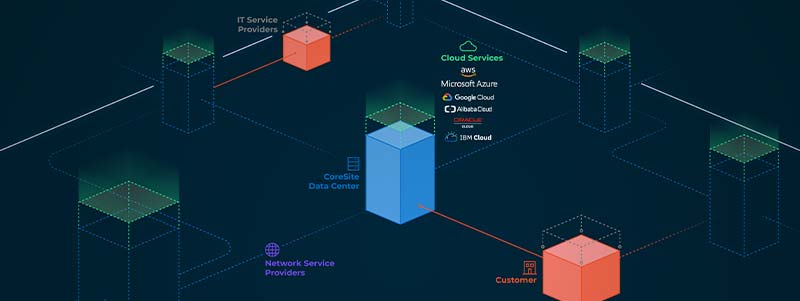
Five Reasons to Migrate to Public, Private and Hybrid Cloud
Although references to the cloud have been around for decades, it remains a fuzzy concept for many people, even including some in IT positions. As a consequence, while the technology has grown and has been adopted by many organizations as their primary computing platform, others are still somewhat wary. So, let’s clarify what the term “cloud” means, how cloud computing works and the substantial benefits it delivers to organizations and individuals.
Cloud Definition and Types
Putting it as simply as possible, the cloud is a metaphor for various types of servers located in data centers that are connected to form a single ecosystem. Employing the cloud enables workforces, via the internet or private networks, to access applications and store and retrieve data critical to running their businesses. Organizations that choose to migrate some or all their applications and data to the cloud do so for a variety of reasons including:
- Always available user access, from any location
- Cost reduction
- High performance for even complex workloads
- Rapid, dynamic scalability to respond to changing business requirements
- Easier and highly secure data backup
- Business continuity and disaster recovery
Some of the confusion regarding the cloud is attributable to where, exactly, clouds are located. To be sure, these clouds are not floating in the sky. Rather, the cloud, or actually the numerous clouds including those operated by companies such as (but not limited to) Amazon, Microsoft, Google, IBM, Alibaba and Oracle, run in data centers all over the world.
There are several types of cloud deployment models designed to accommodate the specific requirements of organizations. These include:
Public Cloud
Public clouds are shared cloud facilities, owned and managed by companies such as those just mentioned, that can be hosted in one or more data centers and that provide customers with internet (and private or direct) access to a variety of Software as a Service (SaaS), Platform as a Service (PaaS), and Infrastructure as a Service (IaaS) capabilities. While multiple companies access these capabilities simultaneously, they do so by invoking separate instances of these services.
Private Cloud
For organizations that are concerned about sharing resources, private clouds comprise servers owned, maintained and controlled exclusively by those organizations. Private clouds provide access to applications and data only to their employees, approved business partners, customers, etc. via the internet or a private network connection. Private clouds can be hosted in an organization’s own data center or in a third-party data center.
Hybrid Cloud
Hybrid cloud deployments combine the use of public and private cloud capabilities and characteristics and may also include organizations’ on-premise servers. The combination of these multiple environments provides businesses with the flexibility to put specific workloads where they can be most appropriately and cost-effectively managed.
Multicloud
Multicloud deployments are variations of hybrid clouds in that they involve the use of multiple public clouds and access to specific services from each of those public clouds.
Notable Cloud Migration Statistics
- According to the Flexera 2022 State of the Cloud Report, all responding organizations are using at least one public or private cloud. Of that group, 96% of respondents utilize at least one public cloud, 84% have at least one private cloud and 80% are using hybrid cloud.1
- Fortinet’s 2022 Cloud Security Report states: “Organizations continue to shift workloads to the cloud at a rapid pace to achieve faster time to market, increased responsiveness to customer needs, and cost reductions. 39% of respondents have more than half of their workloads in the cloud.”2
- Virtana, in an independent research report, revealed that enterprises planned to grow their multi-cloud environments in 2022. It found that 82% of organizations are currently leveraging a multicloud strategy and 78% of organizations have workloads deployed in more than three public clouds.3
- Executives polled in an OpsRamp survey were using some form of public cloud infrastructure. The survey found that 90% of organizations were using cloud services for at least a year. “IT leaders will bet big on cloud infrastructure. 84% expect to move a greater proportion of workloads to the cloud in the next two years [2021-2022]. Some enterprises are a bit more cautious – 16% expect to shift to cloud infrastructure over the next five years [2021-2025]. The time horizon may differ, but public cloud is an unstoppable growth engine.”4
Accenture research finds that “migrating areas of your business to the public cloud can cut your total cost of ownership (TCO) by as much as 40%. That number will only increase as top public cloud providers AWS, Azure and Google improve their services and prices to strengthen their competitive posture.”5
Organizations of All Sizes are Migrating to the Cloud
The availability of these various clouds and the assortment of computing capabilities they enable can eliminate or significantly reduce the need for organizations, from start-ups to large enterprises, to purchase equipment and software, hire and train staff to maintain on-premises equipment. Furthermore, it eliminates the need to provide the power, cooling and other infrastructure components necessary to connect people with assets and services.
For users, cloud computing lessens the need to have devices containing large-capacity hard drives to store applications and various types of structured and unstructured data. High density servers capable of handling that data or GPU-driven graphics are expensive and supply chain issues slow down implementation projects. By enabling users to remotely access all the functionality and information they need from devices with the ability to connect to the internet and with minimal operating software, cloud computing can slash the cost and complexity of running IT systems while efficiently supporting the business needs of dozens, hundreds or thousands of users.
Five Advantages to Leveraging the Power of the Cloud
By moving company applications and data to the cloud, they are always available to end users working from any internet connected device from any location. Most important, cloud service providers ensure that applications are automatically updated, eliminating the need for in-house IT staff to monitor application vendors for updates and to install them manually. Additionally, company data stored in cloud servers is always current and available to multiple end-users simultaneously.
Cost savingsBy leveraging the power and functionality of the cloud, organizations can substantially reduce IT capital expenditures as they do not have to purchase, maintain and manage their own servers, purchase and renew software licenses, lease or build their own data center facilities and equip them with the specialized power, backup power generation and cooling equipment necessary to keep them functioning properly.
Higher performance, elasticity and business agilityCloud service providers invest massive amounts of capital to create, maintain and update their infrastructures to ensure they offer customers the highest possible performance and business agility. Among the benefits to companies that leverage the power of the cloud are rapid, always available access to a host of applications and vast volumes of data; increased input/output operation rates per second; real time up or down scalability as business demands vary; a more efficient development and testing platform, which can reduce time to market for new products and services; and on-demand resource provisioning to enable companies to respond to varying business conditions almost instantly.
Enhanced reliabilityNo server, network or any other component of an IT infrastructure is invulnerable to outages of various types caused by natural disasters or criminal exploits such as viruses and other malware. Cloud infrastructures are designed to anticipate such possibilities and to ensure companies’ business continuity and the recovery of any lost data. Backup generators and cooling systems kick in within seconds in the event of power interruptions or equipment failure, and ongoing system backups to mirrored sites located at other cloud facilities ensure business continuity come what may.
Reduced burden on IT staffBy migrating company hardware and software assets to the cloud, the workload on IT staff of monitoring and managing equipment, applications, data storage and overall security can be significantly reduced. This allows both line of business and IT staff to focus their finite time and resources on activities that directly and positively impact their business’ bottom line.
How CoreSite Helps Organizations Realize the Optimal Value From Their Cloud Investments
CoreSite has made it easier for organizations to leverage the power of the cloud through the numerous services offered in its nationwide network of secure, reliable, high-performance cloud-connected data centers. CoreSite offers organizations a robust digital ecosystem of hundreds of network providers and cloud and IT service providers. Our colocation facilities provide secure, resilient and scalable compute/storage environments complementing on-premises and public cloud IT deployments and eliminating legacy data center build outs and data egress fees. And our unique interconnection capabilities provide extremely low-latency traffic/data exchange among connected parties.
CoreSite’s Open Cloud Exchange® (OCX) has been enabling enterprises, network providers and IT service providers to connect and deliver solutions to our ever-expanding digital ecosystem for nearly a decade. Notably, the OCX features native onramps to major cloud providers including AWS, Azure, Google Cloud, IBM Cloud, Oracle Cloud and Alibaba Cloud, enabling customers to:
- Securely interconnect private infrastructures with public and private cloud resources
- Orchestrate all connections to cloud service providers, network service providers, services and workloads through a single pane of glass
- Facilitate traffic directly between multiple public clouds

Take Advantage of the Cloud with CoreSite
Take the next step to turning what you have read into quantifiable business advantages. Learn more about how CoreSite can help you optimize your use of cloud computing, starting with this Open Cloud Exchange explainer video.








